Sateen Vs Satin Sheets
Sateen and satin sheets offer distinctly different sleeping experiences, with each having unique benefits. You'll find sateen is made from cotton using a specialized 1-under, 4-over weave, creating a soft, durable surface that gets better with washing. Satin, typically crafted from silk or synthetic materials, provides a sleeker, more luxurious feel but requires careful maintenance. While sateen excels in breathability and durability, costing between $40-$125, satin delivers ultimate smoothness but comes at a higher price point ($150+). Your choice depends heavily on personal preferences, maintenance willingness, and budget considerations. Understanding the key differences between these materials will help you make the most informed decision for your bedroom.
This post may contain affiliate links. If you make a purchase through these links, I may earn a commission at no additional cost to you. Additionally, portions of this post may be generated using artificial intelligence (AI) technology. While we strive for accuracy, please be aware that AI-generated content may not always be perfect and should be fact-checked when necessary.
The Spatula Scoops
- Sateen is made from cotton with a 1-under-4-over weave, while satin can be made from silk, polyester, or nylon with floating yarns.
- Sateen offers better breathability and temperature regulation due to cotton construction, while satin tends to trap heat.
- Sateen becomes softer with washing and is more durable, while satin requires delicate care to prevent snags and tears.
- Sateen sheets are typically more affordable ($40-$125) compared to silk satin sheets ($150+) and offer better value through durability.
- Sateen provides a buttery-soft, stable feel, while satin delivers a cooler, slippery sensation with a glossy appearance.
Understanding Sateen and Satin Basics
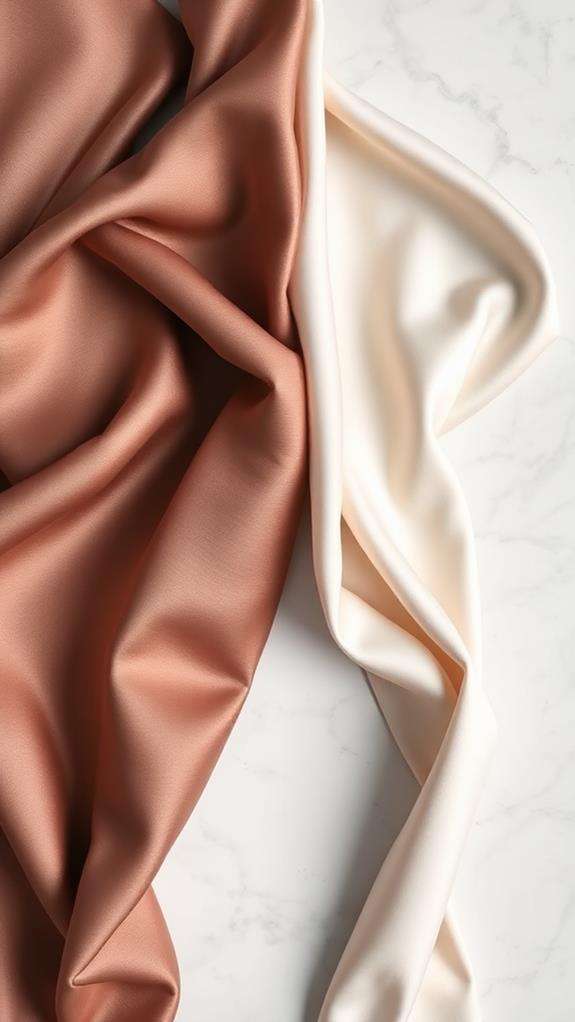
Understanding the key differences between sateen and satin sheets starts with their fundamental construction. While they might look similar at first glance, you'll find that these two luxurious fabrics are quite distinct in their makeup and characteristics.
Sateen is crafted specifically from cotton using a unique weaving technique that places one yarn under and four or more yarns over, creating a remarkably soft and smooth surface that you'll find pleasant to the touch. You'll appreciate its breathable nature, which makes it perfect for year-round use. The cotton construction means you won't have to worry about excessive maintenance, as it's naturally durable and easy to care for.
Satin, on the other hand, isn't limited to one material. You can find satin sheets made from silk, polyester, or nylon, all featuring that characteristic shine on one side and a matte finish on the other. The fabric's float weave creates its distinctive lustrous appearance, though you'll notice it's less breathable than sateen. When you're shopping for sheets, remember that satin's weaving technique prioritizes that sleek, glossy finish over breathability, making it better suited for cooler environments.
Fabric Construction and Materials
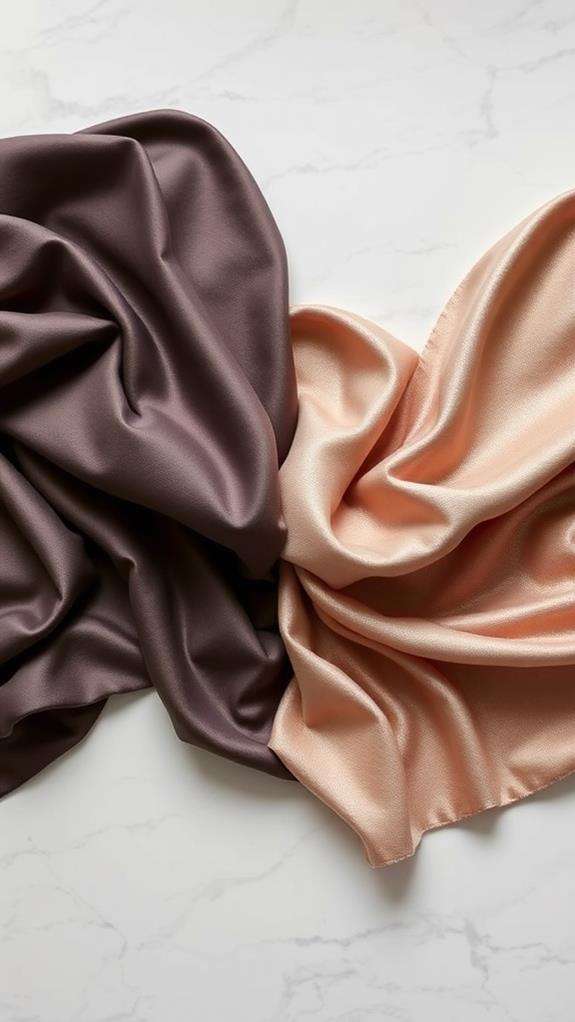
When you're examining how sateen and satin sheets are made, you'll notice their distinct weaving patterns start with different materials: sateen typically uses cotton fibers in a one-under, four-over pattern, while satin employs silk or synthetic filaments in a more complex floating yarn structure. The fiber selection directly impacts the fabric's characteristics, as sateen's cotton composition creates a thicker, more durable weave compared to satin's sleeker, more delicate construction. While both fabrics can achieve high thread counts, you'll find that sateen's denser cotton weave often results in higher numbers, though satin's filament fibers create an equally smooth surface with fewer threads per square inch.
Weaving Patterns and Techniques
The intricate weaving patterns of sateen and satin create distinctly different sheet textures, despite their similar-sounding names. In a sateen weave, you'll find a technique where one yarn goes under while four or more yarns travel over, creating a soft surface primarily using cotton fibers. This unique pattern gives you the luxurious feel you're looking for while maintaining the durability that cotton provides.
When you examine a satin weave, you'll notice it's constructed differently, with multiple floating yarns that create a high-shine finish on one side. You'll typically find satin made from silk, nylon, or polyester, resulting in that characteristic glossy appearance you might associate with formal wear. The weaving technique produces a lighter fabric that's cooler to the touch than sateen.
You'll need to take into account maintenance requirements when choosing between these weaves. Sateen's short-staple spun yarns make it easier to care for, while satin's floating yarn construction means you'll need to handle it more carefully to prevent snags and pilling. The weaving method directly impacts how you'll need to maintain your sheets over time.
Fiber Types and Sources
Both sateen and satin sheets derive their distinct characteristics from fundamentally different fiber sources. When you're shopping for sateen sheets, you'll find they're primarily made from cotton fabric, specifically short-staple cotton yarns that create their signature soft and silky feel. The weaving pattern combines with these natural fibers to produce a durable, breathable surface that's perfect for everyday use.
| Feature | Sateen Sheets | Satin Sheets |
|---|---|---|
| Primary Fiber | Cotton | Silk/Polyester/Nylon |
| Fiber Length | Short-staple | Long filament |
| Care Required | Machine washable | Delicate/Dry clean |
| Durability | High | Moderate |
In contrast, satin sheets are fabric made from continuous filament fibers, with options ranging from luxurious silk to more affordable polyester or nylon. The fiber types used in satin construction create that characteristic high shine you're familiar with, though this comes with additional maintenance requirements. While silk fabric offers the ultimate in luxury, you'll need to reflect that these sheets require more careful handling than their cotton-based sateen counterparts. The choice between these two often comes down to your preference for either natural cotton fibers or synthetic alternatives.
Thread Count Differences
Understanding thread count reveals significant differences between sateen and satin sheet construction. When you're shopping for sateen sheets, you'll find they typically offer thread counts ranging from 300 to 800 per square inch, which directly contributes to their exceptional softness and durability. These higher numbers aren't just for show – they represent the dense, quality construction that makes sateen a reliable choice for your bedroom.
In contrast, while satin weave can vary in thread count, you'll notice that premium silk satin usually starts at around 300 threads per square inch to achieve that luxurious feel you're looking for. However, if you're considering polyester satin, you'll often encounter lower thread counts. The key difference lies in how these threads are constructed: sateen's short-staple yarns enhance breathability and create a softer touch, while satin's delicate fiber construction requires more careful handling. When you're deciding between the two, remember that sateen's higher thread counts also mean you'll get more warmth and weight – perfect if you live in a cooler climate. This density makes sateen more durable for everyday use, while satin may require gentler care to maintain its characteristic sheen.
Comfort and Feel Comparison
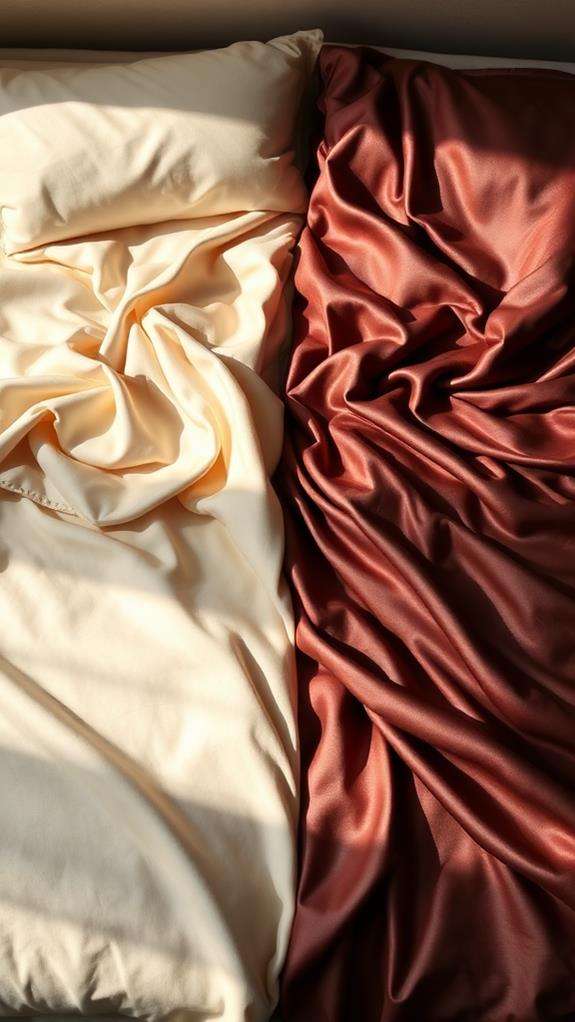
When you're choosing between sateen and satin sheets, you'll notice distinct differences in how they feel against your skin, with sateen offering a buttery-soft, cotton-based texture and satin providing a smooth, glossy sensation. Sateen's natural cotton fibers allow your body to breathe more easily throughout the night, while satin's synthetic construction might trap heat, especially during warmer months. You'll find that sateen strikes a comfortable balance between luxurious feel and practical comfort, though satin's sleek surface might appeal to you if you prefer a more glamorous bedding experience.
Sleep Surface Sensation Differences
From the first touch, sateen and satin sheets offer distinctly different sleeping experiences. When you're choosing between these two options, you'll notice that sateen sheets provide a buttery-smooth feel with a cozy, inviting texture, while satin sheets deliver a cooler, more slippery sensation against your skin. The unique sateen weave creates a soft texture that's particularly appealing if you're looking for temperature-regulating properties during warmer nights.
You'll find several key differences in surface sensations between these bedding types:
- Sateen sheets feature a cotton-based construction that becomes softer with each wash, making them exceptionally easy care
- Satin sheets, especially silk ones, provide a luxurious look with their glossy finish but require more delicate handling
- The sateen weave offers better breathability, preventing that sticky feeling during sleep
- Satin's slicker surface can cause sheets to slide, while sateen tends to stay in place better
Your personal preference will ultimately determine which surface sensation you prefer. If you value a more stable, breathable feel, you'll likely appreciate sateen's balanced texture. However, if you're drawn to that classic smooth feel and cooling properties, satin sheets might be your ideal choice.
Temperature Control Properties
Beyond their distinct surface textures, sateen and satin sheets differ considerably in how they regulate temperature throughout your sleep. If you're looking for breathable bedding, you'll find sateen sheets to be the superior choice, especially during warmer months. Their unique cotton construction allows for better airflow, helping you maintain a comfortable sleeping temperature without overheating.
While satin sheets, particularly those made from silk, are highly prized for their luxurious feel, they can trap heat due to their tighter weave structure. However, there's an exception with silk satin sheets, which offer excellent temperature regulation capabilities, adapting to both warm and cool conditions. You'll appreciate sateen's moisture-wicking properties if you tend to perspire during sleep, as the fabric efficiently manages moisture to keep you dry and comfortable throughout the night.
For hot sleepers, the choice becomes even more essential. Satin's smoother texture can create an insulating effect that might cause discomfort during warmer seasons. In contrast, you'll find that sateen's natural breathability and heat management make it a more practical choice for year-round comfort, especially in warmer climates.
Temperature Regulation Properties
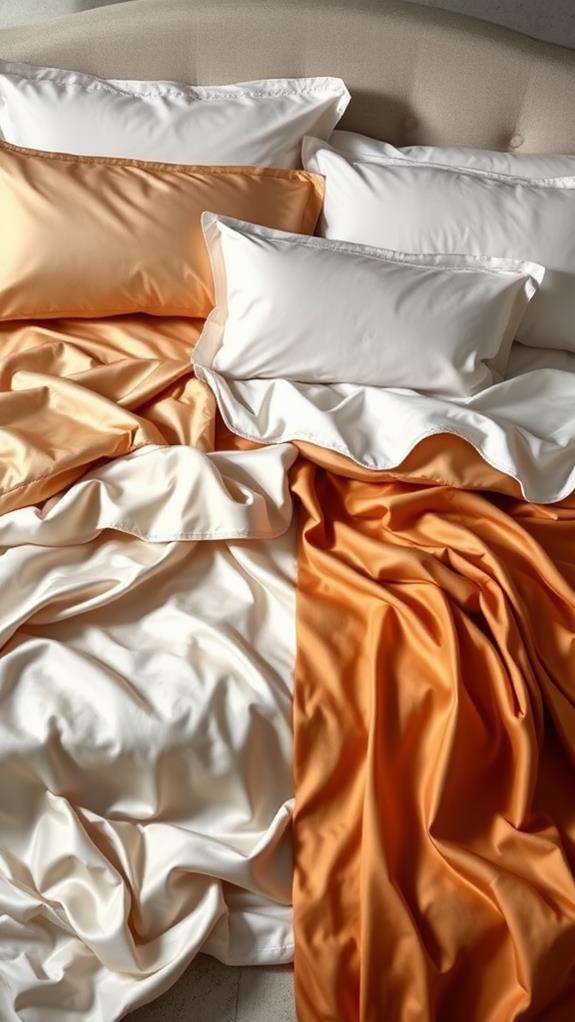
Temperature regulation stands out as a key differentiator between sateen and satin sheets. When you're choosing between these two options, you'll find that sateen sheets offer superior breathability and temperature control due to their cotton fiber construction. The natural properties of sateen allow your bedding to effectively manage heat and moisture throughout the night, guaranteeing you don't wake up feeling uncomfortably warm.
Here's why sateen excels at temperature regulation compared to satin:
- Cotton fibers in sateen sheets actively absorb moisture from your body, helping maintain ideal sleep temperature
- Sateen's weave structure allows air to circulate more freely, preventing heat from becoming trapped
- The natural breathability of sateen helps regulate your body temperature in various climate conditions
- Moisture-wicking properties guarantee sweat evaporates efficiently, keeping you dry and comfortable
In contrast, you'll notice that satin sheets, typically made from synthetic materials, don't offer the same level of temperature control. Their limited breathability often leads to heat retention, which can disrupt your sleep comfort, especially if you're prone to overheating. For ideal temperature regulation, sateen's natural properties make it the more practical choice for year-round comfort.
Durability and Longevity
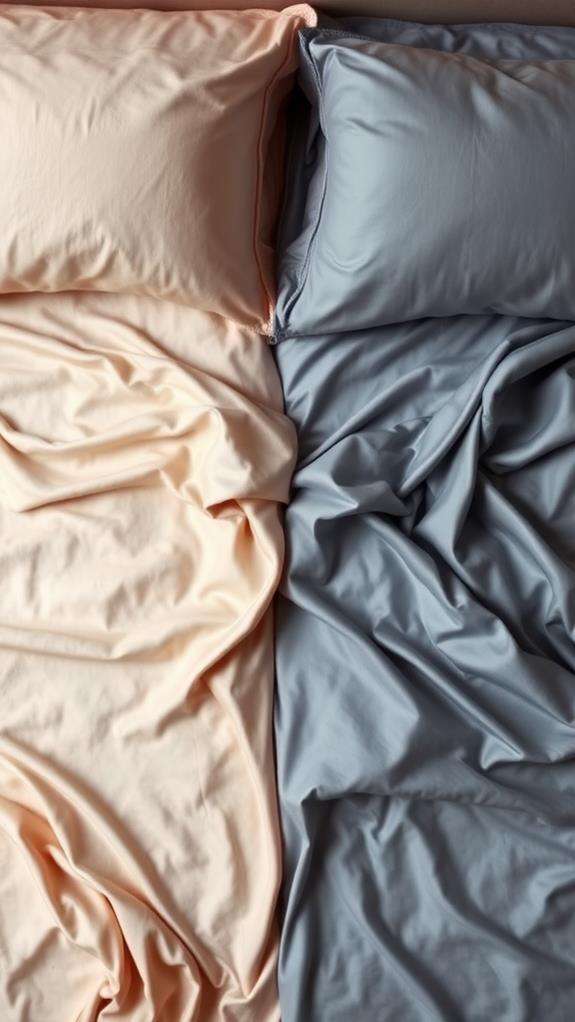
A major consideration alongside temperature control is how long your sheets will last. When you're investing in bedding, you'll want to understand the durability differences between sateen sheets and satin sheets, as they can materially impact your long-term satisfaction.
Sateen sheets typically offer superior durability thanks to their tightly woven structure, which makes them resistant to daily wear and tear. You'll find that high-quality sateen, especially those made with long-staple cotton, won't pill or fray as easily as their satin counterparts. The maintenance of sateen is also more straightforward, as you can machine wash them without worry of damage.
In contrast, satin sheets require more careful handling to maintain their longevity. If you choose satin, particularly silk varieties, you'll need to follow specific care instructions that often include dry cleaning or delicate washing cycles. The fibers in satin sheets are more susceptible to snags and tears, especially when exposed to rough handling or high heat. While high-quality satin can last a long time with proper care, you'll need to be more mindful of maintenance to preserve their condition.
Care and Maintenance Tips
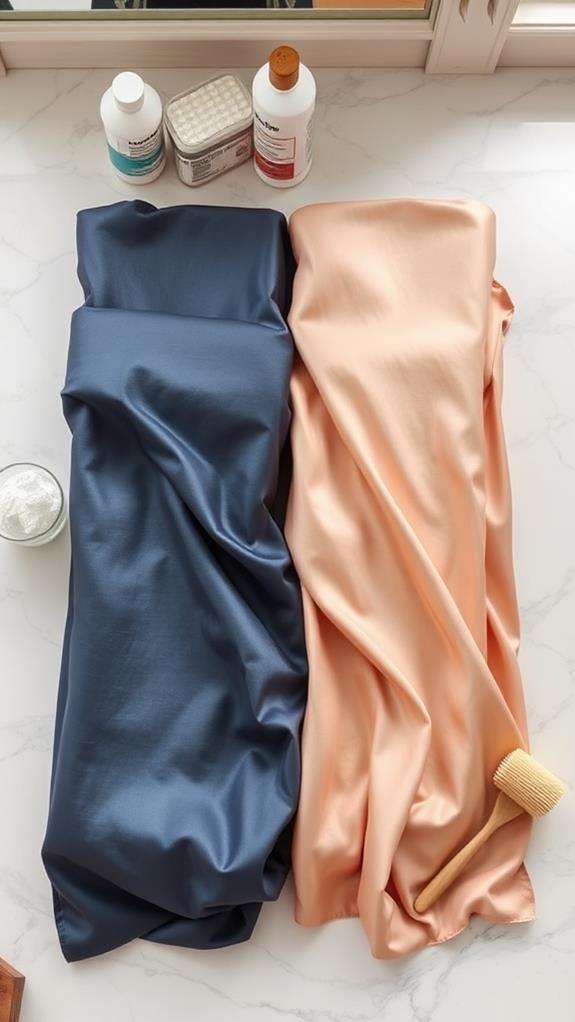
Proper care and maintenance can make or break the lifespan of your luxury sheets. Understanding the specific washing techniques for each type will help you maintain their luxurious appearance and guarantee they last longer.
If you've invested in sateen sheets, you'll be pleased to know they're the most machine washable option. Simply use cool water and mild detergent, then tumble dry on low heat. For satin sheets, you'll need to be more careful – wash them in cold water and skip the fabric softener to prevent pilling and maintain their signature sheen.
When caring for silk sheets, follow these essential steps:
- Use only silk-specific mild detergents
- Hand wash in cold water or use the delicate cycle
- Never wring or twist the fabric while wet
- Allow to air dry away from direct sunlight
For wrinkle removal, both sateen and silk can be ironed on low heat, though silk should be slightly damp during ironing to prevent scorching. By following these specific care instructions for your chosen sheet type, you'll extend their lifespan and preserve their premium quality.
Cost and Value Considerations
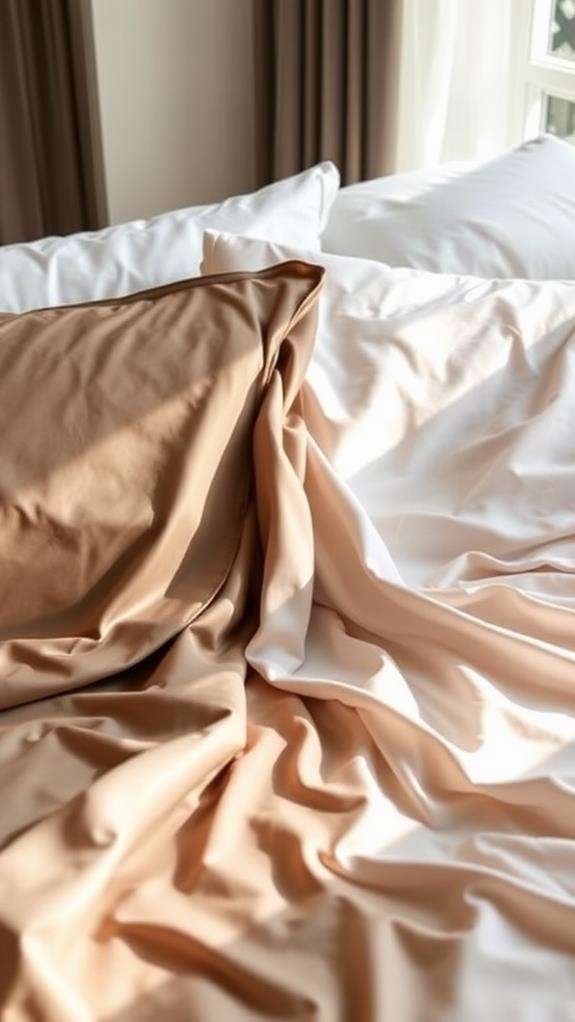
Beyond maintaining your sheets properly, understanding their cost implications helps you make smarter purchasing decisions. When you're shopping for luxury bedding, you'll find that sateen sheets typically range from $40 to $125, while silk satin sheets can cost upwards of $150 for comparable quality. This considerable price difference reflects more than just initial investment considerations.
You'll appreciate that sateen sheets offer excellent value through their durability and practical maintenance requirements. While silk satin sheets provide undeniable luxury, they often need more frequent replacement due to their delicate nature and susceptibility to wear. When you factor in the long-term costs, sateen sheets emerge as the more economical choice, particularly if you're seeking a balance between elegance and practicality.
The investment in high-quality sateen sheets proves worthwhile, as they resist wrinkles and fading while maintaining their luxurious appearance over time. You won't need to replace them as often as silk satin sheets, which translates to substantial savings. Consider your lifestyle and budget when choosing between these options, keeping in mind that sateen's lower maintenance costs contribute considerably to its overall value proposition.
Environmental Impact
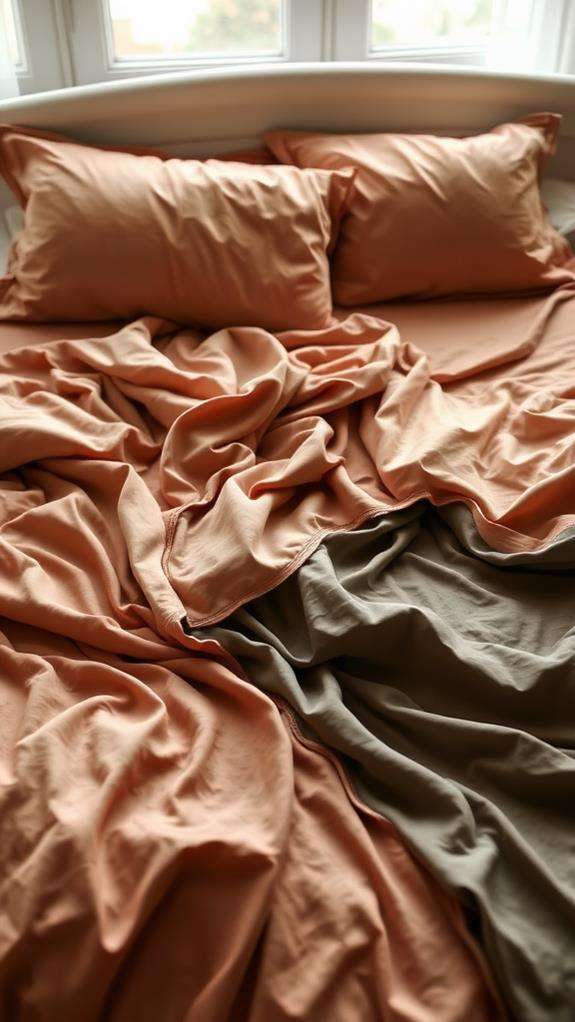
While both bedding options offer unique benefits, their environmental footprints differ considerably. If you're environmentally conscious, you'll want to know that sateen sheets, particularly those made from 100% Egyptian cotton, are the more eco-friendly choice. Through sustainable cotton farming practices, these sheets offer a natural, biodegradable alternative to synthetic materials.
When comparing environmental impact, here are the key differences between sateen and satin sheets:
- Material Source: Sateen uses renewable cotton resources, while satin often relies on petroleum-based synthetic fibers
- Production Process: Cotton farming requires less energy than manufacturing synthetic materials
- Maintenance Requirements: Sateen's care and maintenance needs less water and energy
- End-of-Life Impact: Sateen naturally decomposes, while synthetic satin contributes to plastic pollution
You'll be pleased to know that many manufacturers now offer recycling programs for both types of sheets. These initiatives help reduce landfill waste and promote sustainability in the bedding industry. When you're choosing between sateen and satin sheets, consider that sateen's environmental benefits extend beyond its immediate use, making it a more sustainable long-term investment for your bedroom.
Shopping and Selection Guide
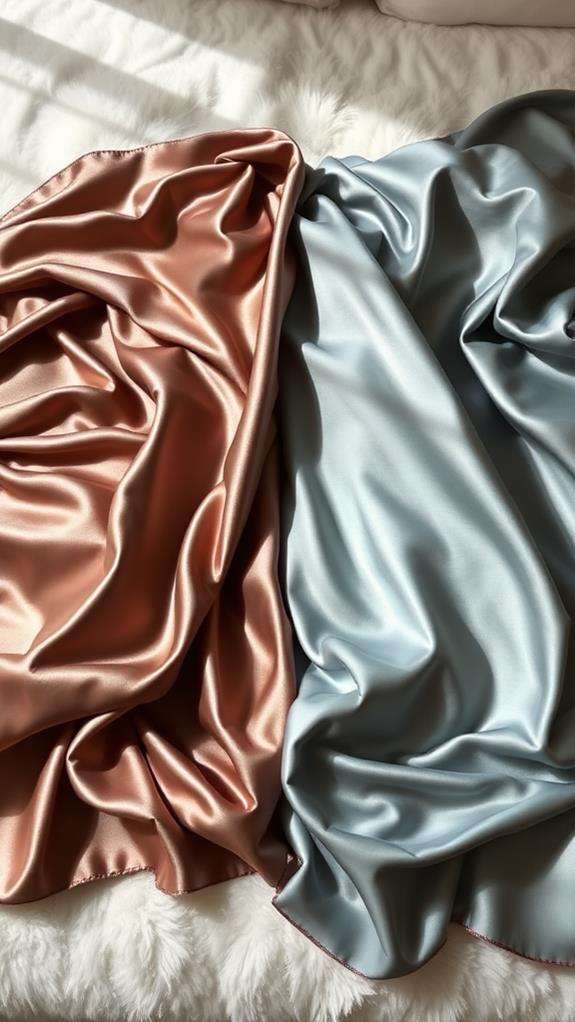
Smart shoppers know that selecting between sateen and satin sheets requires careful consideration of price, care requirements, and personal preferences. When you're exploring bedding materials, you'll find that sateen sheets offer an excellent balance of luxury and comfort at a more affordable price point, while satin sheets provide premium luxury with higher maintenance needs.
To make the best choice, focus on the smooth texture and soft feel you're seeking. If you're looking for durability and easy care, sateen sheets with a high thread count above 300 will give you that silky sensation you desire. However, if you're willing to invest in ultimate luxury, genuine silk satin sheets might be worth the extra expense and careful maintenance.
Don't forget to examine care instructions thoroughly before making your purchase. While you can toss sateen sheets in your regular wash cycle, satin sheets often require special handling. Consider purchasing coordinated bundles that include fitted sheets, pillowcases, and duvet covers to create a cohesive bedroom aesthetic. This approach guarantees all your bedding components complement each other while maintaining the quality and appearance you're looking for.
Frequently Asked Questions
What Is Better, Satin or Sateen Sheets?
Your best choice depends on your specific needs. If you're looking for durability and breathability, especially in warm weather, you'll want sateen sheets, which are also easier to maintain and typically more affordable. However, if you prefer a luxurious, glossy finish and don't mind delicate care requirements, satin might be your pick. Keep in mind that sateen's cotton construction offers better temperature regulation, while satin works well in cooler conditions.
Is Satin or Sateen Better for Skin?
Like choosing between silk and sandpaper, your skin's needs should guide your bedding choice. Sateen's natural cotton fibers are typically better for your skin, as they're more breathable and effectively wick away moisture. While satin feels smooth, it's often made from synthetic materials that can trap heat and sweat. You'll find sateen's combination of smoothness and natural fiber composition helps maintain your skin's balance, making it the superior choice for skin health.
Do Sateen Sheets Feel Like Silk?
While sateen sheets can feel silky smooth, you'll notice they don't quite match silk's distinctive feel. You'll experience a soft, luxurious touch with sateen, but it's more of a cotton-based smoothness rather than silk's natural sleekness. The weave pattern gives sateen its smooth texture, but you won't get silk's unique temperature regulation or that characteristic sheen. Think of sateen as silk's comfortable cousin – similar but with its own unique characteristics.
Is Sateen as Good as Satin for Hair?
While sateen offers some hair benefits, it's not quite as effective as satin for protecting your hair. You'll find that satin, especially silk satin, creates less friction against your hair, which means fewer tangles and less breakage while you sleep. Though sateen's softer texture is gentler than regular cotton, it doesn't match satin's superior ability to maintain moisture, preserve hairstyles, and prevent frizz, particularly for curly or textured hair.





